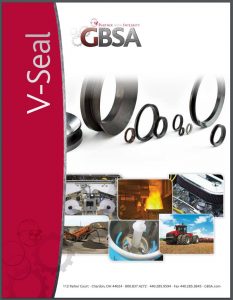V-Seals Technical Information
V-Seal Styles
V-Seal Dimensions
The basic dimensions of the V-seals are as follows: (i.e for a V-25 A)
d – The molded inside diameter of the V-seal = .087”
d1 – The shaft range the V-seal is made to fit = .095-1.07
d2 – The maximum I.D. of the counterface = d1 + 0.08
d3 – The minimum O.D. of the counterface = d1 + 0.45
A – I.D. width of the V-seal = .018
B – O.D. width of the V-seal = 0.30
C – V-seal cross section = 0.1
B1 – V-seal fitted width = 0.24+/-0.03
V-Seal Selection
Because v-seals have such light contact pressure, they generate very little friction and lower amounts of heat than other seal types. Lower heat translates to longer life.
In addition to temperature and compatibility, the following must be considered when selecting a v-seal:
- Materials
- Shaft Finishes
- Tolerance
- Speed
Materials
The v-seal is available in different rubber materials designed for various operating conditions.
Nitrile (NBR): This standard material is the most widely used v-seal material. It resists grease, oil, fuels and water, and can withstand temperatures between -40 and 225°F.
Viton (Fluoroelastomer): This material has a higher temperature and chemical resistance than nitrile. It can withstand temperatures between -30 and 325°F in dynamic applications or temperatures between -50 and 450°F in static applications.
Anti Friction Treatment (AFT): Our proprietary anti-friction treatment reduces friction by as much as 75%, allowing for lower heat and longer life. The treatment penetrates the seal surface, so it remains present even as the seal wears.
In addition to the materials listed above we also offer:
- Ethylene Propylene (EPDM/EPM)
- FDA and NSF approved rubbers
- Fluorocarbon (FPM)
- Fluorosilicone (VMQ)
- Neoprene(CR)
- Polyacrylic (ACM)
- Silicone (VMQ)
- Therban (HNBR)
If you did not see your desired material above, our compound lab can develop specialty materials for particular applications. Call today to speak with an engineer.
Shaft Finishes
Because the v-seal mounts on the shaft instead of running against it, there are no stringent requirements for shaft finish or hardness. The roughness of the shaft will also have no effect on the seal.
Although the counterface surface on which the seal rides does not have stringent finish requirements either, we recommend 32-63u RMS. The hardness of the counterface can be as low as 32 Rc.
Tolerance
Because the v-seal is all rubber, it is very forgiving with regard to tolerances. For example, the same size v-seal made to fit a 1” diameter shaft will fit any shaft size – inch or metric – between .95” and 1.07”. The recommended fitted width of this seal is .24”, but the tolerance of this dimension is ±0.3”.
Speed
In most applications, the v-seal rotates with the shaft to provide a slinging action. As such, it is subject to centrifugal force.
- At speeds 1600 surface feet per minute (fpm), the stretch tension of the v-seal is sufficient to hold it to the shaft.
- Above 1600 fpm, axial backup is required.
- Above 2400 fpm, radial backup is required. Radial backup can be in the form of a mounting pocket or clamp around the v-seal body.
- Above 3000 fpm, the lip of the v-seal lifts away from the counterface resulting in a clearance seal and eliminating drag and wear.
The v-seal can also be mounted stationary and run against a rotating counterface. In this case, centrifugal force has no effect on the v-seal.

